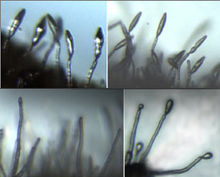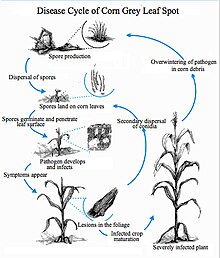Grey leaf spot (GLS) is a foliar fungal disease that affects maize, also known as corn. There are two fungal pathogens that cause GLS, which are Cercospora zeae-maydis and Cercospora zeina . Symptoms seen on corn include leaf lesions, discoloration (chlorosis), and foliar blight. The fungus survives in debris of topsoil and infects healthy crop via asexual spores called conidia. Environmental conditions that best suit infection and growth include moist, humid, and warm climates. Poor airflow, low sunlight, overcrowding, improper soil nutrient and irrigation management, and poor soil drainage can all contribute to the propagation of the disease. Management techniques include crop resistance, crop rotation, residue management, use of fungicides, and weed control. The purpose of disease management is to prevent the amount of secondary disease cycles as well as to protect leaf area from damage prior to grain formation. Corn grey leaf spot is an important disease of corn production in the United States, economically significant throughout the Midwest and Mid-Atlantic regions. However, it is also prevalent in Africa, Central America, China, Europe, India, Mexico, the Philippines, northern South America, and Southeast Asia. The teleomorph (sexual phase) of Cercospora Zeae-Maydis is assumed to be Mycosphaerella sp.
Host and Symptoms
Corn is the only species that can be affected by Cercospora zeae-maydis. There are two populations of Cercospora zeae-maydis, distinguished by molecular analysis, growth rate, geographic distribution, and cercosporin toxin production. Cercospora Zeae-Maydis differs from its cousin group Cercospera zeina sp. nov in that it has faster growth rate in artificial media, the ability to produce the toxin cercosporin, longer conidiophores, and broadly fusiform conidia. Cercospera zeina sp. nov affects corn in the Eastern Corn Belt and Mid-Atlantic States; Cercospora Zeae-Maydis is found in most corn producing areas of western Kentucky, Illinois, Indiana, Iowa, Wisconsin, Missouri, Ohio, and west Tennessee (Midwest). Both populations share the same symptoms and virulence, the ability of the fungus to invade the host.
Major outbreaks of grey leaf spot occur whenever favorable weather conditions are present (see Environment section). The initial symptoms of grey leaf spot emerge as small, dark, moist spots that are encircled by a thin, yellow radiance (lesions forming). The tissue within the “spot” begins to die as spot size increases into longer, narrower leaf lesions. Although initially brownish and yellow, the characteristic grey color that follows is due to the production of grey fungal spores (conidia) on the lesion surface. These symptoms that are similar in shape, size and discoloration, are also prevalent on the corn husks and leaf sheaths. Leaf sheath lesions are not surrounded by a yellow radiance, rather a brown or dark purple radiance. This dark brown or purple discoloration on leaf sheaths is also characteristic to northern corn leaf blight (Exserohilum turcicum), southern corn leaf blight (Bipolaris maydis), or northern corn leaf spot (Bipolaris zeicola). Corn grey leaf spot mature lesions are easily diagnosed and distinguishable from these other diseases. Mature corn grey leaf spot lesions have brown rectangular and vein limited shape. Secondary and tertiary leaf veins limit the width of the lesion and sometimes individual lesions can combine to blight entire leaves.
Pathogenesis
One reason for the pathogenic success of Cercospora zeae-maydis is the production of a plant toxin called cercosporin. All members of the Cercospora genus produce this light-activated toxin during infection. In the absence of light, cercosporin is inactive, but when light is present, the toxin is converted into its excited triplet state. Activated cercosporin reacts with oxygen molecules, generating active single oxygen radicals. Oxygen radicals react with plant cell lipids, proteins, and nucleic acids, damaging and killing affected cells, and nutrients released during the cell rupture and death feed the Cercospora fungus. A study of mutant Cercospora lacking the gene responsible for cercosporin production demonstrates that, though unnecessary for infection, cercosporin increases the virulence of Cercospora fungi.
Disease Cycle
Cercospora zeae-maydis survives only as long as infected corn debris is present; however, it is a poor soil competitor. The debris on the soil surface is a cause for primary inoculation that infects the incoming corn crop for the next season. By late spring, conidia (asexual spores) are produced by Cercospora zeae-maydis in the debris through wind dispersal or rain. The conidia are disseminated and eventually infect new corn crop. In order for the pathogen to actually infect the host, high relative humidity and moisture (dew) on the leaves are necessary for inoculation. Primary inoculation occurs on lower regions of younger leaves, where conidia germinate across leaf surfaces and penetrate through stomata via a flattened hyphal organ, an appressorium. Cercospora zeae-maydis is atypical in that its conidia can grow and survive for days before penetration, unlike most spores that need to penetrate within hours to ensure survival. Once infection occurs, the conidia are produced in these lower leaf regions. Assuming favorable weather conditions (see Environment Section), these conidia serve as secondary inoculum for upper leaf regions, as well as husks and sheaths (where it can also overwinter and produce conidia the following season). Additionally, wind and heavy rains tend to disperse the conidia during many secondary cycles to other parts of the field causing more secondary cycles of infection. If conditions are unfavorable for inoculation, the pathogen undergoes a state of dormancy during the winter season and reactivates when conditions favorable to inoculation return (moist, humid) the following season. The fungus overwinters as stromata (mixture of plant tissues and fungal mycelium) in leaf debris, which give rise to conidia causing primary inoculations the following spring and summer.



